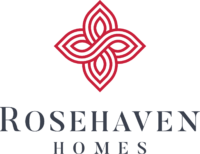Green Building Standards
Rosehaven Homes is on a journey toward building beautiful, NetZero-Ready homes that cost about the same as any similar home on the market. We have a plan to get there and by purchasing a home from us, you put us one step closer to achieving our goal. Thank you!
We offer three levels of Green Building Practices set at the community level. See below for details.
What's Included in GBS 1.0?
Electric Vehicle Ready
Transportation is responsible for about 28% of all greenhouse gas emissions, so we can't get to NetZero as a nation without first switching to electric cars. We believe EV's are the future and want to do our part to help in this transition, so we include one NEMA 14-15, 240 volt outlet in each garage. It can be used to charge a car in the garage or in the driveway. Just plug in, charge up, and go!
LED Lighting
LED lights use about 75% less energy than traditional incandescent bulbs. We only install LED lights in our homes and to keep them beautiful inside, we only use warm 2,700 to 3,200 lumen bulbs, which produce light very similar to incandescents.
Energy Efficient Windows
Windows are the number one source of heat entering your home. Why is that? When heat from the sun hits your exterior walls, the heat must travel through the siding, lumber, and insulation before it can make it into your home. But when it hits a window, especially a single-paned window, much of that heat makes it directly into your home. That's why we only use double-paned, insulated, energy-star windows with Low-E glass that reflects UV and thermal heat back out of the home. We couple this with thick, white, faux-wood blinds that can reflect the full spectrum of light out of your home.
Fiberglass Insulation
The best way to make a home energy efficient is to insulate it well. GBS 1.0 uses fiberglass batt insulation in the walls and blown fiberglass insulation in the attic to significantly reduce heat transfer, keeping your home warm in the winter and cool in the summer. This translates to less reliance on heating and cooling systems, leading to lower energy consumption and a reduced carbon footprint.
Fresh Air Ventilation
Having a well-sealed home keeps humid air, allergens, and other unwanted pollutants out. To keep fresh air in, all GBS 1.0+ homes are equipped with a ventilation system, which brings fresh, outside air through a filter and then into your home.
GBS 2.0 Includes Everything in GBS 1.0 Plus:
All Electric
A NetZero home needs to be able to run without any fossil fuels. In GBS 2.0 and 3.0 communities, our AC systems, water heaters, stove tops, and ovens are all powered by electricity. That means in San Antonio, they are 21% powered by renewables and in Austin they are 43% powered by renewables, since that is how much renewable power is already on the grid in those cities.
Foam Insulation
Air leakage accounts for up to 40% of energy used for heating or cooling a home. Air leakage also lets in humid air, pollutants, allergens, dust, drafts, and unwanted noise. Air-sealing is therefore an essential strategy for making a home comfortable and energy efficient, especially when you consider your AC is the greatest source of home energy consumption. GBS 2.0 homes replace fiberglass insulation with open cell spray foam on all exterior wall cavities and below the roof deck, greatly reducing the amount of air leakage throughout the home. (Includes approximately 3.5 inches / R-13 at exterior walls and 5.5 inches / R-20 at the roof deck.)
Conditioned Attic
In a vented attic, outside air is allowed in, which means in the summer your attic can reach temperatures close to 145 degrees Fahrenheit. This sounds like a strange strategy in itself, but it gets stranger when you consider the attic is where your home's air handler and ductwork is located. That means your cooling system, while attempting to get your air down to 55 degrees, is operating in a virtual oven. It's no surprise that by making the attic part of the interior conditioned space and using spray foam in the exterior walls, you can reduce energy consumption by as much as 22%.
GBS 2.0 = Energy Savings at Zero Cost
Rosehaven's GBS 2.0 should lower energy consumption by about 30% compared to the average new home, making it a triple win in terms of providing extra value at no additional cost. It reduces emissions, which is good for the environment; it lowers energy costs, which is good for owners; and it makes our homes much more comfortable, which is good for everyone. When taken together with our commitment to beautiful, classic home designs, we believe our homes are the best value on the market. Come visit us today to learn more.
GBS 3.0 Includes Everything in GBS 2.0 Plus:
Solar-Ready
No home can get to NetZero without adding a solar array. To be considered “NetZero capable,” a home must generally have a HERS score (Home Energy Rating System) of 55 (the lower the better) and include a range of additional features, such as foam insulation, high efficiency appliances, and a heat-pump water heater. To make adding solar power easier for our GBS 3.0 customers, we prepare the electric panel for solar power during construction and include a conduit installed toward the roof to make connecting the solar panels as easy as possible.
Advanced Air Sealing
To get to the next level of energy efficiency, GBS 3.0 homes undergo more rigorous duct leakage and house envelope sealing and testing and produce incredible results. HERS ratings are usually in the mid 40’s, completely blowing away local standards for energy efficiency.
Heat Pump Water Heater
A home’s water heater is responsible for about 20% of its energy usage. Heat pump water heaters use the same technology found in advanced air conditioning systems and can be up to 4 times more efficient as a standard electric water heater and use up to 70% less energy. All GBS 3.0 homes come standard with a highly efficient, energy-saving heat pump water heater, meaning those long showers can now be guilt-free!
Smart Thermostat
A smart thermostat can reduce your heating and cooling costs by up to 8% by entering a low-power standby mode when not in use, learning your temperature preferences, and reducing energy use when you’re away from your home. When combined with all of our other GBS 3.0 features, a smart thermostat can make a significant contribution to your home’s energy efficiency.
GBS 3.0 = Amazing Savings at Zero Cost
Rosehaven's GBS 3.0 should lower energy consumption by an astonishing 45% compared to the average new home, making it our most ambitious Green Building Standard to date. When you factor in that most utilities are already powered by at least 21% renewable energy, GBS 3.0 could reduce home energy consumption by about 56%. Adding a solar panel array would reduce your energy needs even further, getting you incredibly close to NetZero.
We are committed to saving you money through our commitment to high-performance homes made possible by green building technology. We are on a path toward making all of our homes NetZero emissions homes, and by purchasing a home from us, you put us one step closer to achieving our goal. Thank you!
Visit us today to learn more.
“We believe all new homes should be carbon-neutral, NetZero homes. As we scale out our company, we believe we can deliver NetZero homes at the same price as any similar home on the market and we're forever grateful to our customers who make our journey toward NetZero possible.”- Martin Rico, CEO
What's Next?
Real World Testing
Over the next several years, we'll benchmark our Green Building Standards to provide real-world performance metrics. By monitoring actual energy consumption by individual devices in homes and cross-referencing that with the number of occupants and other factors, we'll be able have a much better understanding of how to continue to improve our Green Building Standards.
Green Building Standard: The Next Version
When we decided to make NetZero homes our goal, our first thought was to put solar panels on every home and call it a day. Of course, once we dug deep into building science, it became clear the first thing to do was to lower the energy requirements of our homes as much as possible with passive energy efficiency enhancements.
With the release of Green Building Standard 3.0, we are approaching the limits of what can be done with efficiency enhancements and getting very close to our goal of NetZero homes. For our next and final version (GBS 4.0), we are currently researching high efficiency heat pump air conditioners, exterior insulation, and making a solar panel array an option in the home-buying process.


